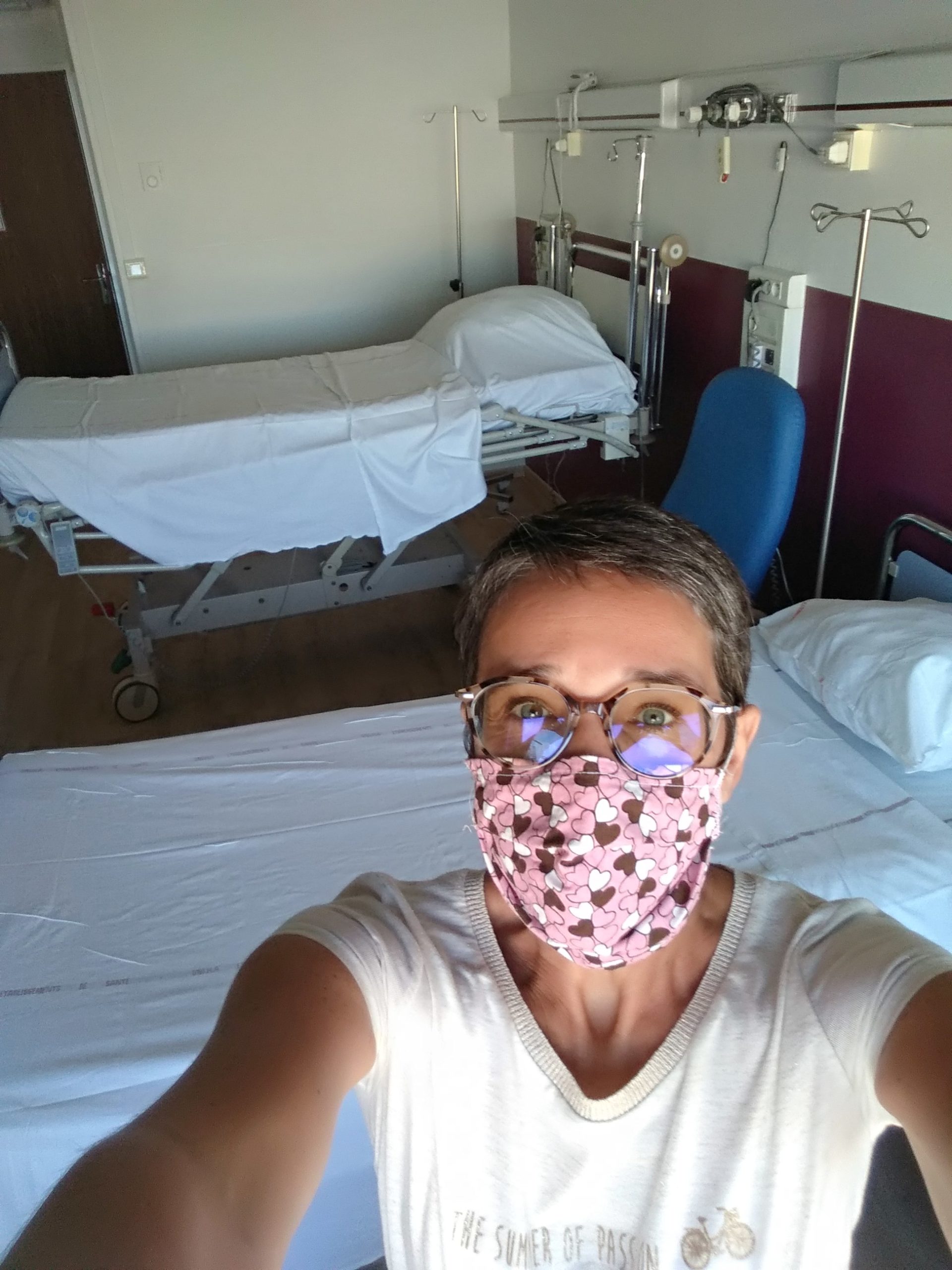Abbreviation
MRI Magnetic resonance
Traf7 Factor 7 associated with the TNF receiver
Introduction
Meningioma is the most frequent intracranial tumor, mainly occurring in women and developed from meningo-arachnoid cells [1]. The presence of hormonal receptors in meningiomas is well established, with a predominance of progesterone receptors [2]. Genetic alterations have also been reported in patients with meningiomas [3-5]. Recently, cyproterone acetate, a synthetic progestin with anti-Androgenal properties (indicated in France in major hirsutism in women) was associated with a risk of dose and time dependent [6]. Since 2018, in France, magnetic resonance imaging (MRI) inexposed systematic cerebral has been recommended by the French health authorities [7].
However, the role of genetic factors in the occurrence of meningiomas after exposure to cyproterone acetate remains discussed. We have brought back 2 cases of meningiomas in 35 -year -old homozygous twin sisters exposed to cyproterone acetate, levonorgestrel and ethinylestradiol.
Case report 1
Three frontal meningiomas were diagnosed in an asymptomatic woman. The patient was exposed to cyproterone acetate for hirsutism (50 mg/day) and to estroprogestative contraception containing levonorgestrel and ethinylestradiol (respectively 50 μg/30 μg for 6 days; 75 μg/40 μg for 5 days and 125 μg for 10 days). Hirsutism had been stable since adolescence without a notion of high severity hirsutism and decreased slightly with cyproterone acetate.
Cyproterone acetate was taken for 8 years and arrested 6 months before the diagnosis of meningioma and estroprogestative contraception was taken for 7 years and arrested on cerebral MRI. Imaging results have shown a 35 mm wide right frontal meningioma and two left frontal meningiomas (not specified sizes). A control MRI, carried out 6 months later, showed a decrease in the width of right frontal meningioma (new width: 31 mm) and stability of the other two. There was no significant worsening of hirsutism during the monitoring of meningiomas.
The causality between meningiomas and drugs containing sex hormones has been evaluated "plausible" (i2) for exposure to cyproterone and "possible" (i1) for exposure to levonorgestrel/ethinylestradiol according to the French method of pharmacovigilance [8].
Case report 2
Frontal meningioma has been diagnosed in the twin -fed sister also asymptomatic. It was exposed to cyproterone acetate for hirsutism (50 mg/day) and to estroprogestative contraception containing levonorgestrel and ethinylestradiol (respectively 50 μg/30 μg for 6 days; 75 μg/40 μg for 5 days and 125 μg/30 μg for 10 days). Hirsutism had been stable since adolescence without a notion of high severity hirsutism and slightly decreased with cyproterone acetate.
Cyproterone acetate and estroprogestive contraception were taken for 9 years and arrested respectively a year and two years before the diagnosis of meningioma. The patient was also exposed to estradiol (2 mg/day) for one year (arrested 5 months before the diagnosis of meningioma) and to levothyroxine (100 μg/day) for 11 years (without interruption). Systematic brain MRI found a 15 mm wide right frontal meningioma. A control MRI carried out 6 months later showed a significant decrease in the width of meningioma (new width: 9.5 mm). There was no significant worsening of hirsutism during the monitoring of meningioma.
The causal link between meningiomas and drugs containing sex hormones has been evaluated as "plausible" (I2) for exposure to cyproterone and "possible" (I1) for exposure to levonorgestrel/ethinylestradiol and estradiol according to the French pharmacovigilance method [8].
Discussion
Meningiomas in homozygous twins are rare. To our knowledge, these reports are the first published by twins after a long period of exposure to cyproterone acetate. These two cases reports support the hypothesis of genetic susceptibilities in the occurrence of meningiomas after exposure to cyproterone acetate. The pathophysiological mechanism for the development of meningiomas after exposure to cyproterone acetate is generally explained by the presence of hormonal receptors on meningiomas and more frequently those of progesterone [9].
Long -term exposure to 50 mg/day of cyproterone acetate and the decrease in the width of meningiomas after stopping this drug strengthen this causality. Levonorgestrel and ethinylestradiol have also been suspected even if the low exposure dose suggests a lower involvement in the development of meningiomas. The decrease in the size of meningiomas in the two twins after stopping hormonal drugs reinforces the causal relationship between these drugs and the adverse effect.
As always, genetic alterations have also been described in meningiomas [3-5]. The main ones were aberrations of the NF2 gene on chromosome 22 (3.4), but others were identified, as mutations in the factor of factor 7 associated with the TNF receiver (Traf7) coding for the Ligase E3 Pro-Apoptotic Ubiquitin [5]. A statistically significant relationship between the increase or decrease in the expression of certain genes and the presence of the progesterone receptor was found in the study of Claus [3], mainly genes located on the long arm of chromosome 22 but also on chromosomes 2, 3 and 4. Another study [9] has found a significantly lower frequency of NF2 mutations and a significantly higher frequency Traf7 mutations in meningiomas associated with progesterone compared to witness meningiomas (not stimulated by progesterone). Genomic alterations in the phosphatidylinositol 3-kinase (PI3K) pathways were also found associated with meningiomas sensitive to progesterone [9,10]. MILLIS et al. [10] showed over -expression of progesterone receptors in 33% of cases of solid tumors with mutation of the Pi3K track against only 13% in cases of solid tumors without mutation of the Pi3K track.
Due to the size and location of meningiomas in the two sisters, no surgical treatment was necessary and no genetic analysis could be carried out. However, the simultaneous appearance of meningiomas after exposure similar to cyproterone acetate (dose and duration of exposure) in these two homozygous twin sisters suggests that a common genetic mutation may influence the occurrence of this unwanted drug reaction.
In clinical practice, the discovery of meningioma should systematically lead to seeking exposure to cyproterone acetate or any other direct or indirect modulator of the progesterone receptor.
Declaration of interest
The authors declare that they have no competing interests.
References
[1] Wiemels J, Wrensch M, Claus EB. Epidemiology and Etiology ofmeningioma. J Neurooncol 2010; 99: 307—14.
[2] IPLIKCIOGLU AC, Hatiboglu MA, Ozek E, Ozcan D. Is Proges-Teron Receptor Status Really A Prognostic Factor for Intracranialmeningiomas? Clin neurol neurosurg 2014; 124: 119—22.
[3] Claus EB, Park PJ, Carroll R, Chan J, Black PM. Specific genesexpressed in Association with Progesterone Receptors in Menin-Gioma. Cancer Res 2008; 68: 314—22.
[4] Yuzawa S, Nishihara H, Tanaka S. Genetic Landscape of Menin-Gioma. Brain Tumor Pathol 2016; 33: 237—47.
[5] Clark Ve, Erson-May Ez, Serin A, Yin J, Cotney J, Ozdu-Man K, et al. Genomic Analysis of NONF2 Meningiomasreveals Mutations in Traf7, KLF4, AKT1, and SMO. Science2013; 339: 1077—80.
[6] ANSM. Cyproterone acetate (Androcur and its generics) and risk of meningiom: publication of the report of the study of pharmaco-epidemiology.; 2019.https: //ansm.sante.fr/s-informer/points-d-information-points-d-information/acetate-de-cyproterone-androcur-et-ses-ses-generiques-et-risque-de-meningiome-publication-du-rapport-complet-de-l-Etude-de-pharmaco-Epidemiology-point-d-Information. [Accesed April 27, 2020].
[7] ANSM. Androcur and generics (Cyproterone acetate, 50 mg and 100 mg) and risk of meningiom: the PUB-LIE ANSM of recommendations for Despatate care-Information Point-ANSM: National Agency for Medicines and Health Products; 2018.https: //www.ansm.sante.fr/s-informer/points-d-information-points-d-information/androcur-et-generiques-acetate-de-cyproterone- 50-MG-ET-12-MG-ET-RISQUE-DE-MANINGIOME-L-ANSM-PUBLIE-DES-Recommandations-Pour-La-prise-en-CHARGE-DES-PATIENTS-POINT-D-INFORMATION. [AcCESSEDAPRIL 27, 2020].
[8] Miremont-Salamé G, Théophile H, Haramburu F, Bégaud B. Causality Assessment in Pharmacovigilance: The French Methodand its successive updates. Therapy 2016; 71: 179—86.
[9] Peyre M, Gaillard S, de Marcellus C, Giry M, Bielle F, Villac, et al. Progestin-associated shift of meningioma mutationallandscape. Ann Oncol 2018; 29: 681—6.
[10] MILLIS SZ, Ikeda S, Reddy S, Gatalica Z, Kurzrock R. Landscapeof phosphatidylinositol-3-kinase pathway alterations across19,784 various solid tumors. Jama Oncol 2016; 2: 1565—73.
Link to the study: htt ps: //pubmed.ncbi.nlm.nih.gov/32418729/
Study pdf: https://amavea.org/wp-content/uploads/meningiomas-after-cyloterone-cetateexposure.pdf





